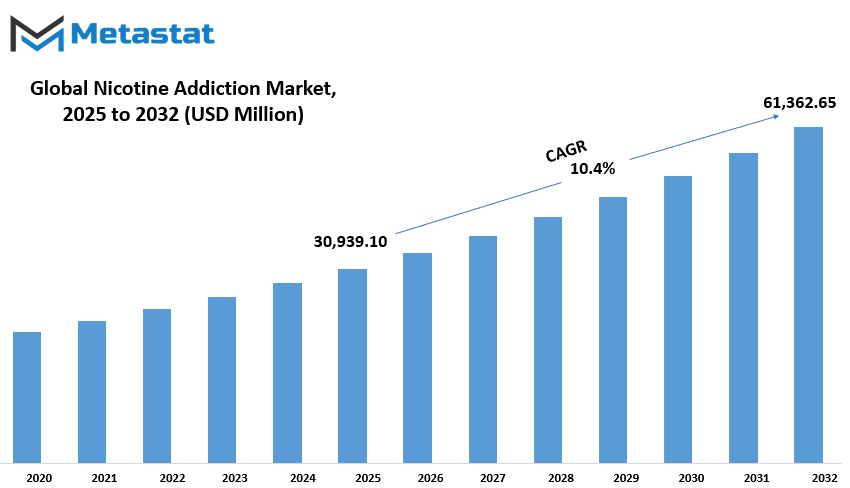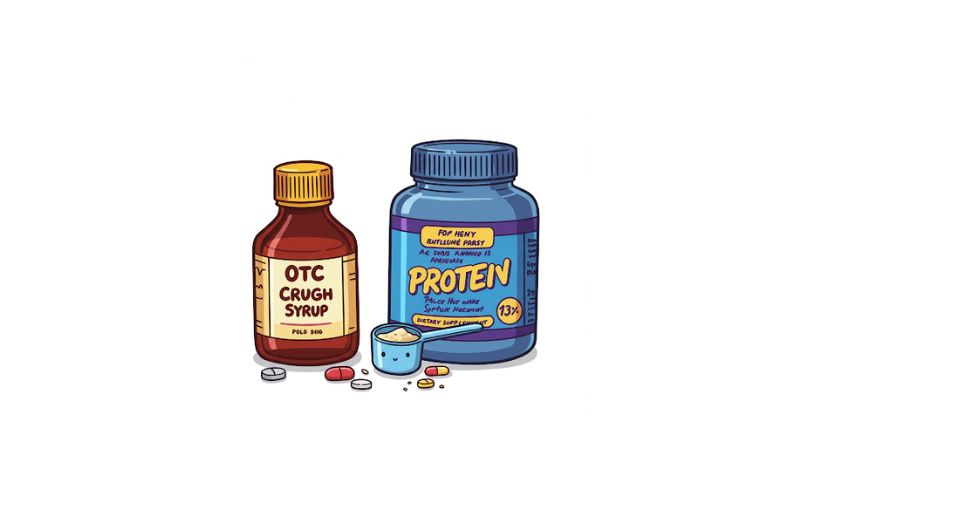MARKET OVERVIEW
The global nicotine addiction market and its industries, which are undergoing major change due to changing consumer behavior, advancements in technology, and a bureaucratic landscape. This market has historically been viewed from the narrow perspective of cigarette consumption and nicotine replacement therapies, but a wider look liberates the market from these traditional rules. New trends and innovations are now shaping a market that has begun to think about products not just as isolated product categories but rather integrated sectors of biotechnology, behavioral science, and digital health solutions.
One more defining aspect of this industry is the growing intersection of technology and addiction management. Digital health interventions are becoming more important than ever, supporting applications, virtual therapy platforms, and AI-based support systems. All of these include personalization for people who want alternatives to nicotine dependence. These companies are moving away from a pure medical approach and looking to integrate behavioral therapies with real-time data analytics into adaptive treatment solutions. The intersection of technology and addiction science stipulates that whatever technology development will be geared toward meeting the needs of individual persons, instead of a generalized solution.
Scientific advancements continue to redefine the landscape, with biotech firms pursuing novel approaches to nicotine intake in the realm of the unconventional. Interest in the research of various compounds similar to nicotine in physiological and psychological effects but inactive as addictive agents appears to be on the rise. Neuropharmacological advances are shifting the target away from the mere modulation of brain chemistry in order to assist in craving changes. These innovations denote an intervention attempting to take in even more novel forms than what a patch or vape as previously considered.
That being said, whatever consumers do have an interest in is now weighing on the conscience of the Global Nicotine Addiction market. Such awareness of health risks is impacted by these purchases. More and more people are now consciously looking for harm reduction alternatives that don't just replace nicotine consumption but also deal with behavioral and psychological dependencies.
This transition is causing companies to focus their investments in holistic wellness solutions, including mindfulness, cognitive-behavioral therapy, and lifestyle changes. Such an approach embodies a more contemporary ethos in which addiction management does not mean merely replacing substances but rather promoting a full bouquet of health wellness.
It seems that regulation will play its part in deciding what happens in the future. Governments and health organizations everywhere are re-examining their policies to try to strike a balance between harm reduction and public health concerns. Stricter advertising laws, taxation practices, and ingredient disclosures may impact how companies promote their concepts. At the same time, regulators are assessing the viability of other systems of nicotine delivery, natural or synthetic, and their long-term impact. All this dynamic will unwind the rules of the game that will determine who stays and which innovations earn prominence.
The influence across sectors from mental health and wellness is now poised to deregulatively impact the conventional market too. Among others, psychological support for nicotine withdrawal has begun to draw increasing attention, with research outlining the close link between addiction and mental health. This awareness is encouraging cooperation between the mental health domain and addiction specialists, fostering a biome of treatment that integrates both physical and psychological parameters.
The Global Nicotine Addiction market is about to enter areas II-IV beyond its convention on scientific, technological, and behavioral levels to provide multidimensional solutions. In the next few years, the industry will be increasingly viewed as a far broader vision, not limited to conventional cessation products but embracing innovation and personalized care in addressing nicotine dependence.
Global Nicotine Addiction market is estimated to reach $61,362.65 Million by 2032; growing at a CAGR of 10.4% from 2025 to 2032.

GROWTH FACTORS
Many thresholds of initiative are since raised in the setting of the global nicotine addiction market, mainly associated with the increasing consumption of e-cigarettes and vaping products. The evolution of lifestyle adds with the increase of stress, taking into nicotine many individuals as a coping measure. The improved access and variety of nicotine-based substances have further pushed the market toward greater acceptance by the previous users and newer ones. It is mainly among young adults that vaping has implicity been viewed as a much less harmful alternative to conventional cigarettes. The supply of flavored e-liquids and sophisticated vaping devices has further increased the pressure, making this segment one of the fastest-growing in the market.
It has also brought several areas that may be turned into obstacles for this growth. Governments around the world are coming up with strict regulations, and some entirely ban a few nicotine products. The aim is to deny nicotine users even among the younger populations most of the health effects associated with nicotine use. For this purpose, many countries impose increased taxes, advertisements are restricted, and warnings are put on the packaging to prevent usage.
Another factor that made the shift of consumer preference was the increasing awareness regarding the long-term health effects of nicotine addiction. More consumers would consider the potential dangers of nicotine and look out for some of the alternative products that could reduce harm. Public awareness and educational campaigns have further informed people regarding the risks and subsequently made them rethink their consumption of nicotine.
There remain opportunities in what is going to be the very best part of the market at the moment, that is basically smoking cessation products. People are becoming made aware about nicotine addiction, and with this rise in awareness, the demand for products that will provide alternatives to help them quit smoking is on the rise. Nicotine replacement therapies such as patches, gums and lozenges are rapidly gaining traction with consumers who try to reduce their dependency.
Pharmaceutical companies as well as health organizations are now attempting to invest more into creating innovative products to be availed to people who are on the process of quitting. Now, inventions of digital health tools such as mobile apps or online support groups are coming up to provide guidance and motivation to those who are in the process of quitting.
The nicotine addiction sector is growing in the face of all obstacles; these are mainly financial and health related challenges, which have to be overcome with changing consumer behaviors. The future of this industry will be determined by the balance between development in the market and public health concerns. Companies in this area will need to be adaptive to new and stricter policies while finding new opportunities in harm reduction and smoking cessation. Answering to the continuous changes, the market will see rising challenges side by advancements in the next few years.
MARKET SEGMENTATION
By Type
Millions of people all over the world struggle with nicotine addiction, and that is why the need for solutions to help people quit or reduce tobacco consumption is high. The global nicotine-addiction market has enjoyed steady growth, with myriad products and treatments available for various forms of nicotine dependence. It can be broken down into medicine-based treatments, therapy programs, and alternative remedies; each highly relevant to helping users recover. Among those, the pharmacological section has its largest share of $15,943.09 million, which implies a greater focus on pharmacotherapies for the smoking cessation efforts.
These pharmacotherapy interventions include nicotine replacement therapies either through OTC-published patches, gums, lozenges, or through prescription options for withdrawal symptomatology. These cater controlled parameters of nicotine into the body so as to minimize cravings and thus help one stop using tobacco. These prescription-only medications such as varenicline and bupropion also play an indispensable role in the management of cravings by acting on some receptors in the brain that mediate nicotine dependence. Thus, in the goodwill of all smoking cessation and welfare campaigns against smoking, there has also been a booming market for pharmacological therapy.
The significant therapy interventions in the management of nicotine addiction involve offering both behavioral and psychological support to quitters. Through counseling, cognitive behavioral therapy, and support groups, individuals can gain tools to help them identify their triggers, develop coping strategies, and learn better behaviors. Joining therapy and pharmacological treatments together helps many people because the treatment of the physical and psychological aspects of addiction improves the chance of success. Online and mobile-only therapies have improved access and allowed for guidance and motivation without requiring an office visit.
Outside traditional measures, the unconventional nicotine addictions solutions have gained some attention, including harm-reducing alternative products. E-cigarettes and heated tobacco products have been promoted as lower-risk options for traditional smoking, although their long-term effects remain controversial. Herbals and non-nicotine solutions would also appeal to people who want to naturally manage their craving.
The world's nicotine addiction market is dynamic in nature and changes along with the developments in the research area and innovations for available treatment. Greater awareness among people about the danger posed by the habit of smoking and the continuous efforts by the healthcare organizations, governments, and advocacy groups have increased the demand for efficacious solutions. The mix of pharmacological options, therapies, and alternative products has given every resource one may require to quit-the combination of which makes it possible for many individuals to reclaim their lives and break free from nicotine dependence.
By Distribution Channel
The Global Nicotine Addiction market is dictated by factors such as lifestyle change, health awareness regarding smoking, and emerging technologies in cessation products. People have rapidly become conscious about health and smoking: hence, the demand for products based on alternative ways to quit or reduce dependence on nicotine has increased. It means that the market is growing since companies are coming forth with new product development to satisfy consumer demand.
The increasingly growing numbers of smokers trying to quit have also turned into the forces driving growth in the market. It becomes hard for nicotine-dependent persons to quit unaided; hence, there lies an opportunity for pharmaceutical companies and health providers to help with therapy options like nicotine replacement therapy products-patches, gums, and lozenges. These alternative nicotines relieve withdrawal symptoms and aid the patient in moving forward with quitting smoking.
The market is also affected by the regulatory needs and interventions geared toward smoking cessation by the government. The countries are now putting in place stricter laws incentive of higher taxation on tobacco products, bans on smoking in public places, and public awareness campaigns about tobacco smoking dangers. These measures will act as a motivation for the population to search for alternatives and hence increase the demand for such alternatives for nicotine addiction treatment. Digital health platforms have similarly widened their reach, giving access for people to seek help via mobile apps and online counseling services.
On distribution-channel grounds, the market has been segmented into hospital pharmacies, retail pharmacies, and online pharmacies. Hospital pharmacies serve a crucial role in supplying nicotine addiction treatments, namely to patients in hospital care. Retail pharmacies offer easy accessibility to a range of over-the-counter products, allowing the consumer to simply walk in and buy some form of nicotine replacement therapy. Internet pharmacies have gained popularity over the past few years because of their facility in delivering discreet assistance to those needing to procure stop-smoking products. Thanks to e-commerce, a rapidly growing populace has a common avenue in which to compare products, browse reviews, and buy items online.
While there has been continuous effort to encourage quitting smoking, there still exist barriers to quitting. Due to nicotine's addictive potential, many putative quitters relapse and need further interventions and support through the quit process. In the nicotine addiction market, companies are developing new products and technologies by modifying their formulations and delivery systems to increase efficacy. The industry looks forward to technological and scientific enhancement of solutions to provide better support to people in establishing a nicotine-free life.
By End Users
Over the past few years, the nicotine addiction market has been undergoing drastic changes all over the world due to shifting consumer preferences and regulatory policies and also development in alternative nicotine products. Increased awareness of health hazards has stimulated the demand for relatively less harmful alternatives, such as e-cigarettes and nicotine patches and gums. These products serve different age groups as the use habits and attitudes towards them vary.
Among end users, the most important group of consumer segments is Generation Z. This is because social media and digital marketing trends are driving such consumers to e-cigarettes and vapour. They view vaping and e-cigarettes as a new replacement for traditional smoking. Vaping or smoking any e-cigarette product is appealing because of its flavour, health risk reduction, and potentially discreet use. It has raised concerns about nicotine dependency resulting in stricter regulations and awareness campaigns against underage consumers.
Many millennials tend to form a significant user group, with a shift from conventional smoking to various substitute forms of nicotine. Health consciousness and lifestyle choices highly determine the reasons for making purchases. This segment of population usually looks for methods to reduce their intake of nicotine or stop consumption altogether, and thus, a growing need for products such as nicotine replacement therapies and smokeless alternatives is created. Those in the market are innovatively responding to these trends by bringing forth solutions that are more aligned or preferred by this category of consumers.
GenX have a diversified pattern of consumption as they balance work and personal life. Some of them still smoke traditional tobacco products, while some of them switched to health-related alternatives. Most of the individuals in this age group consume nicotine with the belief that it releases their stress, and therefore, they remain a constant segment for both new and traditional nicotine products. Availability of a wide variety such as nicotine lozenges and pouches is beneficial to these people and allows them to consume it conveniently.
The older people among the Silent Generation usually carry on with their already formed smoking habits. A small number have resorted to using alternate products due to health reasons. Although most of them stick to the old method of using tobacco products, many have long habits that deter them from switching to alternatives. Products to help stop smoking like nicotine patches, prescription aids and many others are often sought after by those who want to quit, while this age group would need guidance from health professionals in choosing safer alternatives.
As changes occur in regulations, through consumer awareness and innovations bonded to products, the nicotine addiction market continuously moves forward. Age-matched consumers demand further changes in the way the companies develop their strategies in addressing different preferences while keeping in mind the health aspect. By really looking into these trends, businesses would have better-targeted approaches to meeting the potential consumer in the market and propagating the healthier alternatives.
|
Forecast Period |
2025-2032 |
|
Market Size in 2025 |
$30,939.10 million |
|
Market Size by 2032 |
$61,362.65 Million |
|
Growth Rate from 2025 to 2032 |
10.4% |
|
Base Year |
2025 |
|
Regions Covered |
North America, Europe, Asia-Pacific, South America, Middle East & Africa |
REGIONAL ANALYSIS
Emerging trends bear reference to a recognition of the growth of nicotine product substitutes into the global nicotine addiction market. A growing awareness of health hazards, rising government regulations, and the significant advancement of nicotine replacement therapies have carved out the burgeoning trend in this market. The demand for e-cigarettes, nicotine chewing gum, patches, and lozenges has substantially increased as a growing number of customers seek ways to scale down or quit smoking. Pharmaceutical companies have also directed their efforts toward innovative alternatives to cater to the needs of people in desperate want of help to quit smoking.
The Global Nicotine Addiction Market division is based on geography-North America, Europe, Asia-Pacific, South America, and the Middle East & Africa. In the context of North America, the U.S., Canada, and Mexico comprise this region. A distinct development in the nicotine addiction market has been observed with respect to nicotine cessation programs in the anti-smoking campaigns and a large number of smokers switching to alternatives such as vaping. The Europe division includes a list of nations like the UK, Germany, France, Italy, and others. There are, however, strict regulations concerning tobacco, and the attraction of consumers to harm reduction products continues to advance the region. The Asia-Pacific market consists of Indian, Chinese, Japanese, and South Korean markets and others in the Asia-Pacific realm. Thus, these markets are affected by rising smoking rates, with accompanying government initiatives promoting nicotine replacement therapy.
Nicotine addiction covers South America Brazil, Argentina, and the Rest of South America. Here, the region records slow but gradual growth with rising public awareness concerning the health hazards of smoking. At the same time, the Middle East and Africa cover GCC Countries, Egypt, South Africa, and Rest of Middle East and Africa. Here, the Middle East and Africa face considerable challenges because of the different levels of tobacco control policies as well as cultural differences affecting patterns of nicotine consumption.
Increasingly and very much able to impact on the existence of an industry: the increasing focus on harm reduction and debut of new products into the market. Quite a number of companies are investing in research and development to offer safer alternatives to their clients. Nicotine pouches and heated tobacco products have created exciting new opportunities in the market. Sadly, regulatory uncertainties and health concerns are the real hot potatoes still affecting the fate of this industry. Most governments in varied regions are rolling out initiatives that will govern the monitoring and control of nicotine consumption, leading to changing directions in consumption and even possible product availability.
People will now exert more effort toward nicotine dependency reduction as awareness on the effects of nicotine addiction for long periods expands. Awareness-building campaigns on strict regulations and better-supporting systems bear the future trends of shaping. Adaptation to changing consumer behavior and regulatory landscapes gives a fine chance for companies to flourish in this competitive market.

COMPETITIVE PLAYERS
The nicotine addiction market has expanded significantly over recent years. People around the world are looking for solutions to quit smoking or to decrease their dependence on nicotine. As there is increasing awareness of health problems from tobacco, it is also promoting the practice of quitting smoking. Therefore, demand is raised for nicotine replacement therapies and other types of treatments. All companies in this area are continuously coming up with new and innovative products in this field to match up with the ever-changing world.
Companies have formed a huge chunk of this nicotine addiction market under which they sell various quit smoking products. Some names in this industry include Cipla Limited, Pfizer Inc., Glenmark Pharmaceuticals Limited, Johnson&Johnson Private Limited, Japan Tobacco Inc., GlaxoSmithKline plc, Perrigo Company PLC, and Dr.
The effectiveness of nicotine replacement therapies has made them very popular among persons wanting to quit smoking. Most of these products give controlled amounts of nicotine to the body and thus lessens the withdrawal symptoms and cravings. Eventually, the users slowly reduce nicotine consumption till they can stop it altogether. A few medicines such as varenicline and bupropion act differently, working on receptors in the brain associated with dependence and thereby affecting the pleasure in smoking and will to smoke lessening pleasurability.
Along with medications, behavioral therapy and support groups create a very important part of cessation for nicotine. Many smokers have been reported as being more successful when using medication combined with counseling aids. Healthcare providers and support programs gather informing those interested in quitting primarily on the need to identify triggers, develop effective means of handling barriers to quitting, and maintain motivation along the quitting process.
Regulatory measures available in the market have also been influenced significantly by government policies that have been characterized by very strict policies on tobacco advertising with increasing taxes on cigarettes. These have forced many more smokers to reconsider smoking cessation and, thus, increased the demand for cessation products. Still, the popularity of e-cigarettes and vaping creates new challenges in fulfilling the demand for smoking cessation products. They have been regarded as possible harm-reduction methods in smoking; however, fear and concern remain regarding their effects and addictive potential, especially in young people.
Evidently, with each research development ongoing, this field of nicotine addiction will soon progress to various treatment options. There will be chances of developing more effective therapies with less side effect profiles, thereby making the breaking away from nicotine dependence much easier. The continued support of healthcare professionals, policymakers, and industry authorities will, therefore, be key to helping man live at a better, smoke-free, healthier life.
Nicotine Addiction Market Key Segments:
By Type
- Pharmacological
- Therapies
- Other Types
By Distribution Channel
- Hospital Pharmacy
- Retail Pharmacy
- Online Pharmacy
By End Users
- Generation Z
- Millennials
- Generation X
- Silent Generation
Key Global Nicotine Addiction Industry Players
- Cipla Limited
- Pfizer Inc.
- Glenmark Pharmaceuticals Limited
- Johnson & Johnson Private Limited
- Japan Tobacco Inc.
- GlaxoSmithKline plc
- Perrigo Company PLC
- Dr. Reddy’s Laboratories Limited
WHAT REPORT PROVIDES
- Full in-depth analysis of the parent Industry
- Important changes in market and its dynamics
- Segmentation details of the market
- Former, on-going, and projected market analysis in terms of volume and value
- Assessment of niche industry developments
- Market share analysis
- Key strategies of major players
- Emerging segments and regional growth potential






_Oil_Market_pr.jpg)

 US: +1 3023308252
US: +1 3023308252






